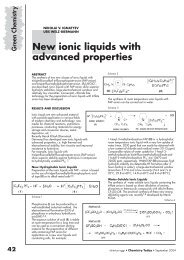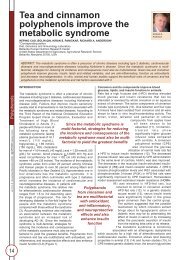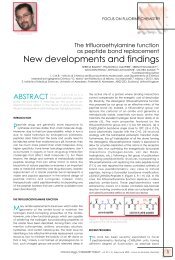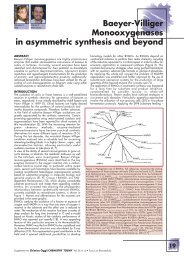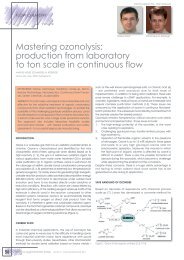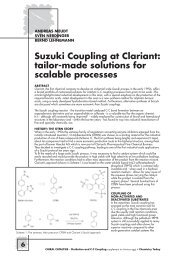Biodeterioration-tests on wood/plastic composites - CHIMICA OGGI ...
Biodeterioration-tests on wood/plastic composites - CHIMICA OGGI ...
Biodeterioration-tests on wood/plastic composites - CHIMICA OGGI ...
Create successful ePaper yourself
Turn your PDF publications into a flip-book with our unique Google optimized e-Paper software.
Biocides<br />
20<br />
INA STEPHAN<br />
RUDY PLARRE<br />
<str<strong>on</strong>g>Biodeteriorati<strong>on</strong></str<strong>on</strong>g>-<str<strong>on</strong>g>tests</str<strong>on</strong>g> <strong>on</strong><br />
<strong>wood</strong>/<strong>plastic</strong> <strong>composites</strong><br />
ABSTRACT<br />
The purpose of this article is to raise awareness about the<br />
possibilities for biodeteriorati<strong>on</strong> of <strong>wood</strong>/<strong>plastic</strong> <strong>composites</strong><br />
(WPCs). It will introduce the European standards (EN) and<br />
technical specificati<strong>on</strong>s (TS) with which the durability of<br />
WPCs against microorganisms and termites can be tested.<br />
INTRODUCTION TO WOOD/PLASTIC<br />
COMPOSITES (WPC)<br />
WPCs are blends of <strong>wood</strong> particles (or in some cases other<br />
cellulosic particles) into a thermo<strong>plastic</strong> matrix. Typically 50<br />
to 70 percent <strong>wood</strong> and 30 to 50 percent polymer are the<br />
ratio limits in which the materials are mixed. They can be<br />
used in outdoor applicati<strong>on</strong>s (e.g. decking, cladding, window<br />
/ door profiles, fences, playground equipment, footbridges,<br />
highway sound barriers, shutters, roofing shingles) as well<br />
as in indoor applicati<strong>on</strong>s (e.g. floors, panels, door frames,<br />
furniture, skirting boards, shelving,<br />
storage equipment).<br />
The predicti<strong>on</strong>s for the growth of<br />
the market are c<strong>on</strong>sistently high.<br />
The actual numbers for selected<br />
countries are quoted in table 1 (1).<br />
Plastic materials used in WPCs<br />
nowadays are mainly polyethylene<br />
(low, medium and high density PE),<br />
polyvinylchloride (PVC) and<br />
polypropylene (PP). In general<br />
<strong>plastic</strong>s used in WPC have to be<br />
suited to being processed at below 200° C in order not to<br />
damage the <strong>wood</strong> particles in the mixture (1).<br />
The slenderness of the <strong>wood</strong> particle defines the characteristics<br />
the <strong>wood</strong> has in a WPC. While <strong>wood</strong> flour (about 0.3 to<br />
0.4 mm diameter) acts as a filler in the WPC, <strong>wood</strong> fibres<br />
or shavings can add structural stiffness to the material (1).<br />
Besides <strong>wood</strong> and <strong>plastic</strong>, additives such as UV-stabilisers<br />
or absorbers and lubricants can be used as coupling agents.<br />
Furthermore, preservatives, e.g. fungicides, insecticides<br />
and/or algicides can be incorporated depending <strong>on</strong> the<br />
intended use of the product.<br />
ACCESSIBILITY OF WPC FOR ORGANISMS<br />
Microorganisms<br />
Wood is a natural, renewable resource. Therefore it is<br />
biodegradable by many organisms in nature. As a general<br />
rule it can be said that <strong>wood</strong> with a high natural durability<br />
is harvested from slow growing tree species, while <strong>wood</strong><br />
with low natural durability is harvested from fast growing<br />
tree species. C<strong>on</strong>sequently, <strong>wood</strong> with a low natural durability<br />
is more accessible <strong>on</strong> the market and cheaper. To delay the<br />
biodegradati<strong>on</strong> process of this <strong>wood</strong> by fungi several opti<strong>on</strong>s<br />
Table 1. Annual use in t<strong>on</strong>nes of WPC materials in selected<br />
countries.<br />
Ina<br />
Stephan<br />
Rudy<br />
Plarre<br />
are possible: a) use of biocides, b) use of modified <strong>wood</strong><br />
or <strong>wood</strong> with a high natural durability c) keeping the <strong>wood</strong><br />
moisture c<strong>on</strong>tent below 25 percent. In this c<strong>on</strong>text, the <strong>plastic</strong><br />
comp<strong>on</strong>ent of a WPC has the potential to envelope the dry<br />
<strong>wood</strong> particles and thus keep the moisture away from it.<br />
Nevertheless, <str<strong>on</strong>g>tests</str<strong>on</strong>g> in the field as well as in the laboratory<br />
dem<strong>on</strong>strated that while moisture uptake is delayed in WPCs,<br />
it cannot always be prevented (2).<br />
To induce <strong>wood</strong> decay and mass loss by microorganisms,<br />
the moisture c<strong>on</strong>tent of the <strong>wood</strong> fibre is critical. Below a<br />
level of 25 percent decay is usually not possible. Therefore,<br />
several authors have focused <strong>on</strong> the water uptake of different<br />
WPC materials (3, 4). While the water uptake over the whole<br />
of the product dimensi<strong>on</strong> might be below 25 percent it has<br />
to be c<strong>on</strong>sidered that the water is not homogenously distributed<br />
in the WPC material. It can be assumed that a) the <strong>plastic</strong><br />
comp<strong>on</strong>ent does not take up any significant amount of water<br />
and b) that there is a moisture gradient with higher levels<br />
of moisture in the outer layer, therefore allowing and favouring<br />
fungal attack in certain parts of the material. This would<br />
lead to the effect that the outer<br />
appearance and surface feel of a<br />
material can change under moist<br />
c<strong>on</strong>diti<strong>on</strong>s whereas the stability of<br />
a product is reduced by fungal<br />
decay at a slower rate, depending<br />
<strong>on</strong> its overall dimensi<strong>on</strong>s (5).<br />
Surface growth<br />
For many customers the surface<br />
appearance is often a reas<strong>on</strong> for<br />
deciding for or against a product.<br />
This is especially true where either large areas of the material<br />
are seen or the product is a c<strong>on</strong>spicuous locati<strong>on</strong>, e.g. with<br />
deckings for terraces. Algal growth and moulds living <strong>on</strong><br />
debris and moisture collecting <strong>on</strong> surfaces are a comm<strong>on</strong><br />
cause for complaints. Even though the WPC-material may<br />
not be metabolised by these organisms, they are known to<br />
build biofilms that could damage <strong>plastic</strong>s and additives by<br />
releasing e.g. organic acids. Research <strong>on</strong> such interacti<strong>on</strong>s<br />
with WPCs is still in its infancy. However, it is already evident<br />
that biofilms make surfaces slippery and decelerate drying<br />
of underlying material, thus enhancing fungal decay.<br />
Insect damage<br />
Several insect species can damage <strong>wood</strong> or <strong>wood</strong> c<strong>on</strong>taining<br />
materials. By far the most important insect group worldwide<br />
causing destructi<strong>on</strong> of <strong>wood</strong> are termites, especially soil<br />
inhabiting and dry <strong>wood</strong> termites (6). They are known to<br />
cause damage throughout the tropics, sub-tropics and temperate<br />
regi<strong>on</strong>s (7). Water is essential for termite survival, however,<br />
<strong>on</strong>ly few termite species demand a minimum moisture c<strong>on</strong>tent<br />
of the <strong>wood</strong> they attack, since they either utilise independent<br />
water sources in the soil or physiologically compensate low<br />
moisture c<strong>on</strong>tents by metabolic water producti<strong>on</strong>.<br />
Termites have a complex social organisati<strong>on</strong> with definite<br />
chimica oggi • Chemistry Today • vol 26 n 3 / May-June 2008
patterns when feeding in groups using all resources to the<br />
maximum (8). Although some preferences for certain <strong>wood</strong><br />
species may occur (9-11), all cellulose c<strong>on</strong>taining material can<br />
be used as food and energy sources. Termites, therefore, feed<br />
<strong>on</strong> any <strong>wood</strong>en material.<br />
As termites, especially subterranean termites, search for<br />
food, they may penetrate and damage many n<strong>on</strong>cellulose<br />
materials as well, including <strong>plastic</strong>s, even if these do not<br />
serve as food source and can not be digested (12). The<br />
sharp mouth parts of worker termites can abrade or break<br />
apart virtually any material and the high<br />
reproductive rate in termites instantly replaces<br />
workers with blunt mandibles.<br />
It is therefore not surprising that most <strong>plastic</strong>s<br />
failed in <str<strong>on</strong>g>tests</str<strong>on</strong>g> for resistance to termites (13-<br />
16). Nevertheless, differences exist between<br />
different <strong>plastic</strong>s and their susceptibility to<br />
termite attack. C<strong>on</strong>densati<strong>on</strong>-<strong>plastic</strong>s like<br />
polyesters appear more resistant than additi<strong>on</strong><strong>plastic</strong>s<br />
like polyethylene, polystyrene and<br />
polyurethane (13). However, it is not <strong>on</strong>ly the<br />
mechanical hardness of <strong>plastic</strong>s that characterises<br />
durability against termite attack, the surface<br />
structure is just as important. Smooth, even<br />
levelled surfaces, are more likely to prevent<br />
termite attack, but the smallest cracks and<br />
crevices or ruffled surfaces and edges provide<br />
immediate access for termite mandibles. The<br />
same holds true for WPCs. Once the surface<br />
is broken, destructi<strong>on</strong> is <strong>on</strong>ly a matter of time<br />
and termite populati<strong>on</strong> density, unless the<br />
material is protected by either an effective<br />
termiticide or a repellent that prevents c<strong>on</strong>tinuous<br />
feeding. Although it was shown that dry<strong>wood</strong><br />
termites are capable of attacking <strong>plastic</strong>s (13),<br />
it is c<strong>on</strong>sidered unlikely that this group of<br />
Wood/<strong>plastic</strong><br />
<strong>composites</strong> (WPC) are a<br />
fairly new category of<br />
materials <strong>on</strong> the market.<br />
The authors point out<br />
biological procedures to<br />
characterise and specify<br />
different WPC-materials.<br />
While moisture is<br />
essential for growths<br />
of algae and fungi,<br />
termites can also attack<br />
dry materials.<br />
Whether biocides<br />
are needed for<br />
protecti<strong>on</strong> of a materials<br />
depends<br />
<strong>on</strong> the envir<strong>on</strong>ment<br />
it will be exposed to<br />
during its use.<br />
termites would infest <strong>plastic</strong>s to establish col<strong>on</strong>ies as they do<br />
in pure <strong>wood</strong>en structures. For WPCs this still needs to be<br />
dem<strong>on</strong>strated.<br />
USE CLASSES FOR WOODEN MATERIALS<br />
Before deciding <strong>on</strong> measures to protect the WPC it is important<br />
to decide where the material has to perform and to what<br />
envir<strong>on</strong>ment it will be exposed. In the field of <strong>wood</strong> protecti<strong>on</strong>,<br />
the definiti<strong>on</strong> of use classes (former hazard<br />
classes) was found to be useful and could now<br />
also be applied to identify the intended use for<br />
WPC-materials (17, 18). These use classes<br />
cover the following general service situati<strong>on</strong>s:<br />
Use class 1 for interior and covered, use class<br />
2 for interior and not covered, use class 3 for<br />
exterior above ground, use class 4 for exterior<br />
in the ground or fresh water and use class 5<br />
for use in salt water. Some minor subdivisi<strong>on</strong>s<br />
in the use classes may occur.<br />
TESTING OF WPCS FOR BIOLOGICAL<br />
DURABILITY<br />
In Europe, CEN with its Technical Committee<br />
249, Working Group 13, has been working <strong>on</strong><br />
laboratory methods to characterise WPCs since<br />
2003. Chapter 8.6 of the technical specificati<strong>on</strong><br />
TS 15534-1released in 2006, “Resistance against<br />
biological agents” (19), deals with the different<br />
forms of microbiological decay (Annex C: termites,<br />
Annex D: <strong>wood</strong> destroying basidiomycetes,<br />
Annex E: soft rotting micro-fungi, Annex F:<br />
discolouring micro-fungi and algae).<br />
Biocides
Biocides<br />
22<br />
The test methods described in TC 15534-1 are intended to<br />
be used for the characterizati<strong>on</strong> and specificati<strong>on</strong> of WPCs.<br />
They are derived from existing test methods in the fields of<br />
<strong>wood</strong> protecti<strong>on</strong>, <strong>plastic</strong>s and coatings. The methods presented,<br />
although used for many years for biocide-treated or untreated<br />
material, were not primarily designed for WPCs. In the future<br />
it is likely that the test methods will need to be adapted to<br />
WPC materials and products.<br />
Laboratory <str<strong>on</strong>g>tests</str<strong>on</strong>g><br />
Accelerated testing in the laboratory can be helpful to rank<br />
resistance against fungal or algal growth of WPC-materials.<br />
TS 15534-1 lists a variety of <str<strong>on</strong>g>tests</str<strong>on</strong>g> (19). Problems associated<br />
with surface moulds <strong>on</strong> <strong>plastic</strong>s (20) and algae <strong>on</strong> coatings<br />
(21) are addressed in test standards which employ visual<br />
estimati<strong>on</strong>s to rate or rank the results. Both standards are<br />
regarded as being useful to estimate the susceptibility of<br />
WPC surfaces to support surface growth <strong>on</strong> WPC-materials.<br />
The following three standards and specificati<strong>on</strong>s (see below)<br />
were all originally developed for testing durability of <strong>wood</strong><br />
and <strong>wood</strong>-based products. While the termite-standard (22)<br />
requires the visual estimati<strong>on</strong> of results, the two methods for<br />
fungal decay determine the mass loss of <strong>wood</strong> in percent<br />
based <strong>on</strong> the original mass of <strong>wood</strong> in a WPC (23, 24). The<br />
appropriate way of prec<strong>on</strong>diti<strong>on</strong>ing (e.g. UV-irradiati<strong>on</strong>,<br />
artificial weathering, leaching) of WPCs before testing is<br />
still a much debated topic. For the simulati<strong>on</strong> of water uptake<br />
in practise (which might take some years in certain envir<strong>on</strong>ments<br />
before the material can be decayed) several standardised<br />
opti<strong>on</strong>s are menti<strong>on</strong>ed in TS 15534 (25-27).<br />
Field <str<strong>on</strong>g>tests</str<strong>on</strong>g> and the fungus cellar<br />
No field <str<strong>on</strong>g>tests</str<strong>on</strong>g> are menti<strong>on</strong>ed in TS 15534. Nevertheless, they<br />
should be c<strong>on</strong>sidered or recommended as a sec<strong>on</strong>d tier after<br />
laboratory <str<strong>on</strong>g>tests</str<strong>on</strong>g>. This is especially the case for the evaluati<strong>on</strong><br />
of resistance to termites, since, under field situati<strong>on</strong>s, WPCs<br />
may be either neglected as a source of food or attacked <strong>on</strong>ly<br />
to a minimum when there is a choice between several food<br />
sources including all sorts of natural, cellulose c<strong>on</strong>taining<br />
materials. For testing WPC-materials or products against<br />
microbial decay the test methods for preservative treated<br />
<strong>wood</strong> can be adopted with success (28). However, since field<br />
<str<strong>on</strong>g>tests</str<strong>on</strong>g> can take several years, methods for accelerated testing<br />
in soil (e.g. fungus cellar) should be c<strong>on</strong>sidered (29, 30).<br />
ENHANCING THE DURABILITY OF WPCS<br />
AGAINST ORGANISMS<br />
As menti<strong>on</strong>ed above, several steps can be c<strong>on</strong>sidered to<br />
improve the resistance of WPC to biological attack. These<br />
c<strong>on</strong>siderati<strong>on</strong>s will certainly also be driven by cost and<br />
intended lifespan. Wood waste from saw mills etc. is a cheap<br />
raw material to substitute <strong>plastic</strong>s with. Wood of fast growing<br />
species is easier to source and therefore cheaper than <strong>wood</strong><br />
from slow growing species. Also, <strong>wood</strong> modificati<strong>on</strong> processes<br />
exist (e.g. acetylati<strong>on</strong>) that improve the resistance against<br />
decay compared to n<strong>on</strong>-modified <strong>wood</strong> (2). However, these<br />
processes have to be performed before the <strong>wood</strong> comes in<br />
c<strong>on</strong>tact with the <strong>plastic</strong> and therefore causes additi<strong>on</strong>al<br />
producti<strong>on</strong> costs. Today, zinc-borate is the major biocide<br />
used in WPCs against a wide range of organisms. It exhibits<br />
fungicidal properties against surface moulds (31) and <strong>wood</strong><br />
decaying fungi and it is termiticidal. It is also thermally stable<br />
and thus compatible with producti<strong>on</strong> process of WPC and<br />
acts a flame retardant for <strong>plastic</strong>s (3). Fungicides acting<br />
against surface moulds <strong>on</strong>ly, e.g. Thiabendazole or DCOITbased<br />
formulati<strong>on</strong>s, are also employed. Anti-algal properties<br />
<strong>on</strong> the surface of WPCs can be introduced into a WPC<br />
material e.g. by algicides such as Terbutryne.<br />
CONCLUSION<br />
Depending <strong>on</strong> the expected life time and type of exposure (see<br />
use classes above), WPCs can become overgrown by and/or<br />
attacked by microorganisms. Furthermore, termites are a hazard<br />
to WPCs in certain regi<strong>on</strong>s of the world. Even if termites <strong>on</strong>ly<br />
attack WPCs under natural field c<strong>on</strong>diti<strong>on</strong>s to a minimum, they<br />
can provide ports of entry for increased moisture and thus<br />
favour microbial decay. Depending <strong>on</strong> the intended use of a<br />
WPC material, its durability and performance should be tested.<br />
TS 15534 lists some tools in this respect. Field <str<strong>on</strong>g>tests</str<strong>on</strong>g> and fungus<br />
cellar <str<strong>on</strong>g>tests</str<strong>on</strong>g> should be c<strong>on</strong>sidered as further opti<strong>on</strong> to characterise<br />
the l<strong>on</strong>g-term stability of a WPC material or products. Further,<br />
tailored test protocols would be advisable to optimise product<br />
developments outside of a given standard.<br />
REFERENCES AND NOTES<br />
1. D. Vogt, M. Karus et al., nova-publicati<strong>on</strong>s, nova-Institut GmbH (2006).<br />
2. P. Larss<strong>on</strong>-Brelid, paper prepared for the 37th meeting of Int. Research<br />
Group <strong>on</strong> Wood Preservati<strong>on</strong>; Tromsoe, Norway, accessible under<br />
www.IRG-wp.org, IRG/WP 06-40338 (2006).<br />
3. W. Wang, J.J. Morrell, Forest Products Journal 54, pp. 209-212 (2004).<br />
4. C.M. Clem<strong>on</strong>s, R.E. Ibach, Forest Products Journal 54, pp. 50-57 (2004).<br />
5. J. Sim<strong>on</strong>sen, C.M. Freitag et al., Holzforschung 54, pp. 2005-2008<br />
(2004).<br />
6. N.E. Hickin, The Insect Factor in Wood Decay, Hutchins<strong>on</strong>, L<strong>on</strong>d<strong>on</strong> (1968).<br />
7. M.J. Pearce., Termites, CAB Internati<strong>on</strong>al (19997).<br />
8. T. Abe, D.E. Bignell et al., Termites: Evoluti<strong>on</strong>, Sociality, Symbioses, Ecology,<br />
Kluwer Academic Publishers (2000).<br />
9. S.S. Bampt<strong>on</strong>, D. Butterworth et al., Material und Organismen 1,<br />
pp. 185-199 (1965/66).<br />
10. D. Butterworth, D. Kay et al., Material und Organismen 1, pp. 257-269<br />
(1965/66).<br />
11. R. Mannesmann, Material und Organismus 8, pp. 107-120 (1973).<br />
12. R.H. Beal, J.K. Mauldin et al., United States Department of Agriculture<br />
Home and Garden Bulletin 64 (1986).<br />
13. G. Becker, Materialprüfung 5, pp. 218-232 (1963).<br />
14. D. Butterworth, D. Kay et al., Material und Organismen 1, pp. 241-255<br />
(1965/66).<br />
15. U. Unger, A. Unger, Plaste und Kautschuk 31, pp. 241-247 (1984).<br />
16. W. Unger, Holztechnologie 26, pp. 240-241 (1985).<br />
17. DIN EN 599-1:1997 Durability of <strong>wood</strong> and <strong>wood</strong>-based products -<br />
Performance of preventive <strong>wood</strong> preservatives as determined by biological<br />
<str<strong>on</strong>g>tests</str<strong>on</strong>g> - Part 1: Specificati<strong>on</strong> according to hazard class (1997).<br />
18. American Wood-Preservers’ Associati<strong>on</strong> Standard, ASTM U1-07 2007 Use<br />
Catergory System: User Specificati<strong>on</strong> for treated <strong>wood</strong> (2007).<br />
19. CEN/TS 15534-1:2006 Wood Plastic Composites (WPC) - Part 1: Test<br />
methods for characterisati<strong>on</strong> of WPC materials and products (2006).<br />
20. ISO/FDIS 16869 “Plastics – Assessment of the effectiveness of fungistatic<br />
compounds in <strong>plastic</strong> formulati<strong>on</strong>s” (2008).<br />
21. EN 15458 “Paints and Varnishes - Laboratory method for testing the<br />
efficacy of film preservatives in a coating against algae” (2007).<br />
22. EN 117: 2005 “Wood preservatives - Determinati<strong>on</strong> of toxic values against<br />
European Reticulitermes species - (Laboratory method)“ (2005).<br />
23. ENV 12038:2002 “Durability of <strong>wood</strong> and <strong>wood</strong>-based products – <strong>wood</strong><br />
based panels - Methods for determining the resistance against <strong>wood</strong>destroying<br />
basidiomycetes” is suitable (2002).<br />
24. CEN/TS 15083-2:2005 “Durability of <strong>wood</strong> and <strong>wood</strong>-based products -<br />
Determinati<strong>on</strong> of the natural durability of solid <strong>wood</strong> against <strong>wood</strong>destroying<br />
fungi, test methods - Part 2: Soft rotting micro-fungi” (2005).<br />
25. DIN EN 927-6:2006 Paints and varnishes - Coating materials and coating<br />
systems for exterior <strong>wood</strong> - Part 6: Exposure of <strong>wood</strong> coatings to artificial<br />
weathering using fluorescent UV lamps and water (2006).<br />
26. DIN EN 321:2002 Wood-based panels - Determinati<strong>on</strong> of moisture<br />
resistance under cyclic test c<strong>on</strong>diti<strong>on</strong>s (2002).<br />
27. DIN EN 152-1:1989 Test methods for <strong>wood</strong> preservatives; laboratory<br />
method for determining the protective effectiveness of a preservative<br />
treatment against blue stain in service (1989).<br />
28. DIN EN 252:1990 Field test method for determining the relative protective<br />
effectiveness of a <strong>wood</strong> preservative in ground c<strong>on</strong>tact (1990).<br />
29. I. Stephan, M. Grinda et al., Internati<strong>on</strong>al Research Group <strong>on</strong> Wood<br />
Preservati<strong>on</strong> DocNo. IRG/WP 98 20149 (1998).<br />
30. J. van Acker, paper prepared for the 37th meeting of Int. Research Group<br />
<strong>on</strong> Wood Preservati<strong>on</strong>; Tromsoe, Norway 2006, accessible under<br />
www.IRG-wp.org, IRG/WP 06-20347 (2006).<br />
31. B.Daws<strong>on</strong>-Andoh, L. Matuna, Holz als Roh - und Werkstoff 65, pp. 331-<br />
334 (2007).<br />
INA STEPHAN, RUDY PLARRE<br />
BAM Federal Institute for Materials Research and Testing<br />
Unter den Eichen 87<br />
Berlin, 12205, Germany<br />
chimica oggi • Chemistry Today • vol 26 n 3 / May-June 2008



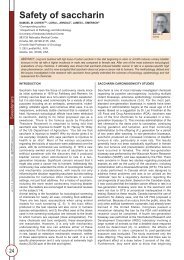
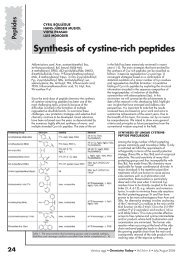
![Pietro Delogu [modalità compatibilità]](https://img.yumpu.com/12255149/1/190x135/pietro-delogu-modalita-compatibilita.jpg?quality=85)
